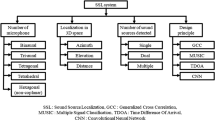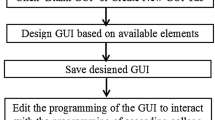Abstract
In hearing aid (HA) systems, amplification of speech signals is done to compensate the hearing loss of patients. Background noise and feedback signals may also get amplified which degrade the intelligibility and quality of speech. To achieve high de-noise efficiency, signal processing unit in HA system has voice activity detector (VAD). The conventional VAD detects voice based on zero crossing rate or energy of input signals. However, these methods cannot perform well at low SNR or non-stationary noise environments. Since pitch is a special characteristic of speech and is basically independent of noise intensity, VAD based on pitch can have high accuracy even when the noise spectrum is changing drastically. In this paper, pitch-based VAD is presented and its accuracy is checked against zero crossing rate-based VAD (ZCR-VAD). For noise reduction, an improved multi-band spectral over-subtraction algorithm is employed along with the high accurate pitch-based VAD. For feedback cancellation, the performance of adaptive algorithms like NLMS, RLS and affine projection (AP) algorithms with pitch-based VAD is compared and it is observed that AP is suitable for feedback cancellation. The proposed noise reduction and feedback cancellation algorithm with pitch-based VAD method is tested with NOIZEUS speech database and with real-time noisy speech signals. The simulation results show that the accuracy of pitch-VAD is about 23% higher than that of ZCR-VAD. The SNR for the proposed noise reduction and feedback cancellation with pitch-VAD method is improved by 10 dB than conventional spectral subtraction and adaptive algorithms. Mean opinion score (MOS) obtained for the proposed method is 4.3 out of 5.















Similar content being viewed by others
References
Y.J. Chen, C.W. Wei, Y. FanChiang, Y.L. Meng, Y.C. Huang, S.J. Jou, Neuromorphic pitch based noise reduction for monosyllable hearing aid system application. IEEE Trans. Circuits Syst. I 61(2), 463–475 (2014)
Y.J. Chen, C.W. Wei, Y.L. Meng, S.J. Jou, Low computational complexity pitch based VAD for dynamic environment in hearing aids. ICCIC, Part V, CCIS 235, 10–17 (2011)
Y.F. Chiang, C.W. Wei, Y.L. Meng, Y.W. Lin, S.J. Jou, Low complexity formant estimation adaptive feedback cancellation for hearing aids using pitch based processing. IEEE/ACM Trans. Audio Speech Lang. Process. 22(8), 1248–1259 (2014)
R. Chinaboina, D.S. Ramkiran, Adaptive algorithms for acoustic echo cancellation in speech processing. Int. J. Res. Rev. Appl. Sci. 7(1), 38–42 (2011)
Y. Ephraim, D. Malah, Speech enhancement using a minimum mean-square error log-spectral amplitude estimator. Proc. IEEE Trans. Acoust. Speech Signal Process. 33(2), 443–445 (1985)
P.K. Ghosh, A. Tsiartas, S. Narayanan, Robust voice activity detection using long term signal variability. Proc. IEEE Trans. Audio Speech Lang. Process. 19(3), 600–613 (2011)
Y. Hu, P.C. Loizou, A generalized subspace approach for enhancing speech corrupted by colored noise. IEEE Trans. Speech Audio Process. 11(4), 334–341 (2003)
M. Karam, H.F. Khazaal, H. Aglan, C. Cole, Noise removal in speech processing using spectral subtraction. J. Signal Inf. Process. 5(02), 32–41 (2014)
Y.T. Kuo, T.J. Lin, Y.T. Li, C.W. Liu, Design and implementation of low-power ANSI S1.11 filter bank for digital hearing aids. IEEE Trans. Circuits Syst. I 57(7), 1684–1696 (2010)
N.N. Lokhande, N.S. Nehe, P.S. Vikhe, Voice activity detection algorithm for speech recognition applications. in Proceedings of International Journal of Computer Applications (2011)
P. Nagaraju, M. Prakash, Comparative study of different adaptive filter algorithms used for effective noise cancellation. Int. J. Eng. Res. Technol. 3(4) (2014) (ISSN: 2278-0181)
J. Ramírez, J.M. Górriz, J.C. Segura, Voice activity detection. Fundamentals and Speech Recognition System Robustness, ISBN 987-3-90213-08-0, p. 460 (2007)
S.A. Samad, A. Hussain, Development of a voice activity controlled noise canceller. Sensors 12, 6727–6745 (2012)
D.S. Shete, S.B. Patil, Zero crossing rate and energy of the speech signal of devanagari script. IOSR J. VLSI Signal Process. 4(1), 1–5 (2014)
Specification for Octave-Band and Fractional-Octave-Band Analog and Digital Filters, ANSI S1.11-2004, Standards Secretariat Acoustical Society of America (2004)
N. Upadhyay, A. Karmakar, An Improved Multi-Band Spectral Subtraction for Enhancing Speech Degraded by Non-Stationary Noises (Elsevier Publications, Amsterdam, 2013), pp. 39–50
E. Verteletskaya, B. Simak, Noise reduction based on modified spectral subtraction method. IAENG Int. J. Comput. Sci. 38, 1 (2011)
Author information
Authors and Affiliations
Corresponding author
Rights and permissions
About this article
Cite this article
Thiagarajan, M., Natarajan, J. & Sharavanaraju, K.M. Pitch-Based Voice Activity Detection for Feedback Cancellation and Noise Reduction in Hearing Aids. Circuits Syst Signal Process 37, 4504–4526 (2018). https://doi.org/10.1007/s00034-018-0776-x
Received:
Revised:
Accepted:
Published:
Issue Date:
DOI: https://doi.org/10.1007/s00034-018-0776-x




